Chrysanthemum: description and varieties, planting and care
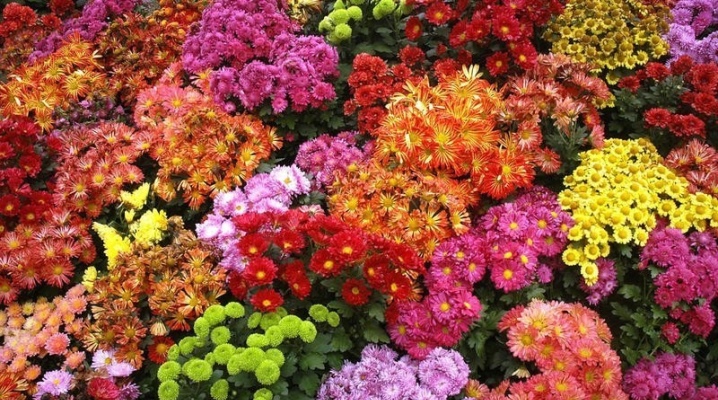
Chrysanthemum is a very beautiful, showy plant that can successfully decorate any garden. It is impossible to pass by this flower without paying attention to it. Many people choose chrysanthemums to decorate their backyards or city apartments. Although the culture is considered unpretentious, this does not mean that it does not need proper care. In this article, we will find out which varieties the chrysanthemum is subdivided into and how to properly care for it.

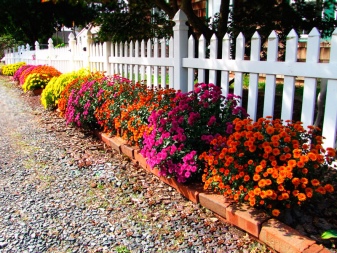
Peculiarities
Chrysanthemum is a beautiful plant that attracts a lot of attention. She got her name due to the many similarities with the warm sun. Translated from Greek, chrysanthemum means "flower-sun". This gorgeous green pet was brought to Europe from the Far East, where she was especially loved and revered. There the chrysanthemum was considered to be the flower of the emperors.
Chrysanthemum is a herb that feels great both on the site and in a convenient pot placed in a house or apartment by the window. It can be of various sizes. Inflorescences are both miniature and large. The height of the stems also varies. For home content, more modest specimens are usually chosen, which grow no higher than 70 cm.
For garden maintenance, you can safely select more solid varieties, the height of which can reach 1.5 m.
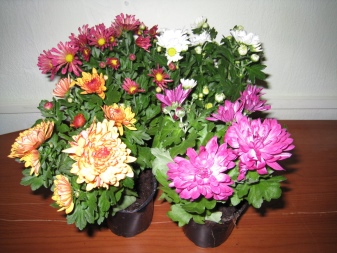
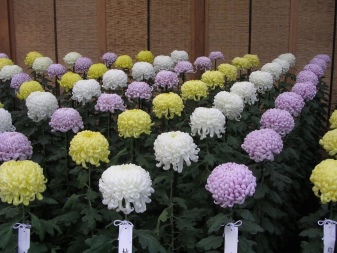
The beautiful chrysanthemum looks very impressive. It is her external qualities that attract most flower growers who want to decorate their homes or adjoining plots. The flowers in question cope with such tasks playfully. Chrysanthemums are famous for their rich, "lively" colors, making them one of the brightest and most attractive plants. Flowers can be white, pink, red, lilac, burgundy and others. Plants can be of the same species, but at the same time have different colors. In the description for such green pets, it will not be possible to find only black.
Chrysanthemum is famous for a large number of varieties and varieties. Thanks to the efforts of breeders, gardeners have the opportunity to grow flowers of various shades both in their personal plots and at home. Most varieties of chrysanthemums are designed to survive in milder, warmer climates. Such specimens are prepared in advance for wintering, or they are completely dug out with the onset of cold weather in order to put them in a safe place, for example, in the basement. There are also some varieties that, with proper care, survive the winters without problems, without losing either beauty or health.
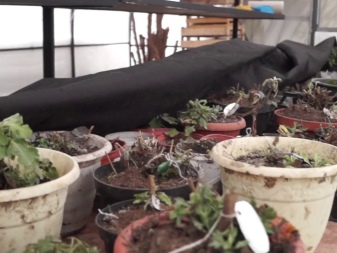
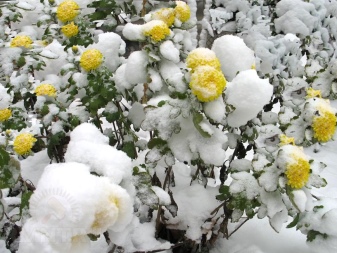
Shoots can be either naked or pubescent. The leaf blades of these plants are characterized by an alternating arrangement. They are ordinary, solid, serrated, dissected. Chrysanthemum foliage can vary in shape and size. In most cases, the flowers of this plant are not very large and are collected in a kind of baskets.
Chrysanthemums are also good because they can be grown without problems at home. They do well in properly sized tanks. The main thing is to provide the plant with proper care, find the optimal place in the house and regularly water and feed. In most cases, for indoor maintenance, flower growers choose small and low flowers, which reach no more than 70-80 cm in height. In the garden, you can also plant taller specimens, the height of which is more than 120 cm.
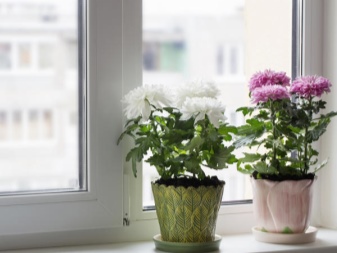
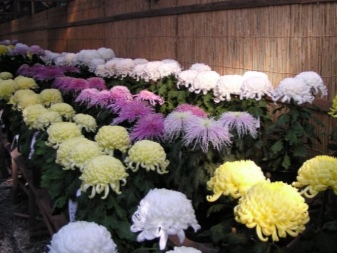
Ground cover chrysanthemum is a safe bet for landscaping.
With this addition, the site becomes more lively and vibrant. Beautiful inflorescences of this famous plant transform the atmosphere, add spectacular colors to it. Paths, entrance areas, gazebos, and other similar elements are decorated with such flowers. A significant advantage of these colors lies not only in their beauty and brightness, but also in their relative simplicity. Any florist will be able to grow a chrysanthemum at home or on his own plot, even if he has not previously dealt with a similar plant. The chrysanthemum will not need very time-consuming and expensive care, so the gardener does not need to have special knowledge and skills.
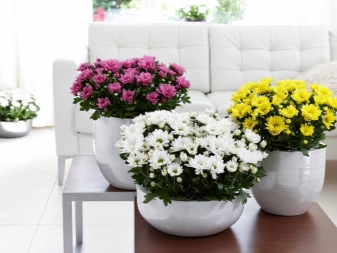
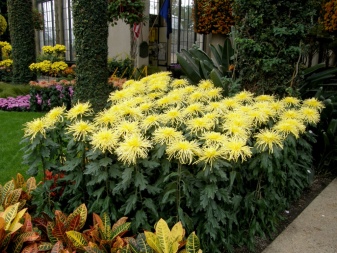
Types and varieties
As mentioned above, chrysanthemum is subdivided into a huge number of subspecies and varieties. Each copy has its own characteristics and external signs. There are enough flowers for the choice of florists that will be able to successfully decorate both the local area and the home interior. Chrysanthemums are subdivided into different types, based on a sufficient number of basic parameters. All chrysanthemums are classified into different varieties according to their life cycles. There are two types of these ornamental plants.
- Annuals. Plants with good immunity. They are hardy. They are allowed to be boldly sown into prepared soil. Annual chrysanthemums are considered unpretentious, so they can be planted for novice gardeners. They bloom for a long time - until the very frost. This type includes such varieties as "Mishung", "Kokard" and others. Crowned chrysanthemum (also called vegetable) is also an annual species.
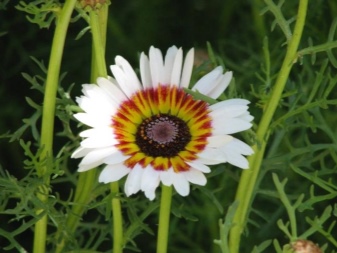

- Perennial. Popular plants known for their rich flowering. Unpretentious specimens that do not need complex care. The unfavorable conditions of perennials are usually not frightening. This subspecies includes greenhouse and Korean varieties (curb, for example, "Goldball", "Florida").
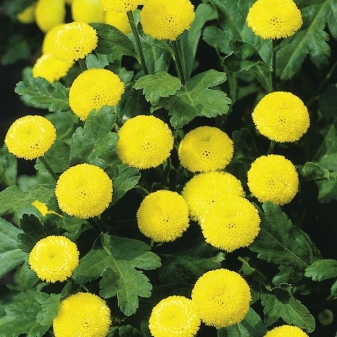
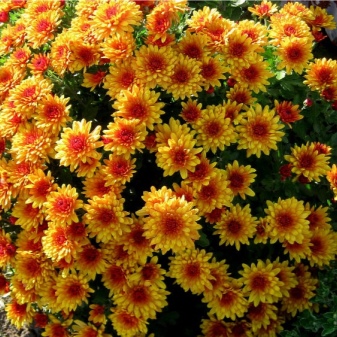
The creatures in question also differ in the time period in which their flowering falls. The following subspecies and varieties are distinguished:
- early - bloom in September, for example, "Hands";
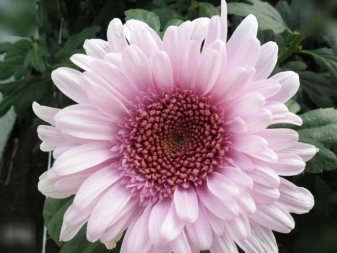

- medium - the flowering of these representatives of the species falls in October; varieties "Froggy", "Orange";
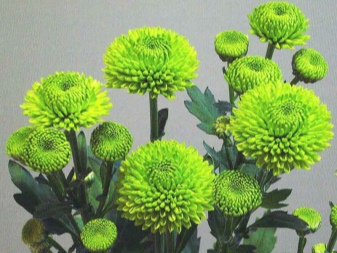
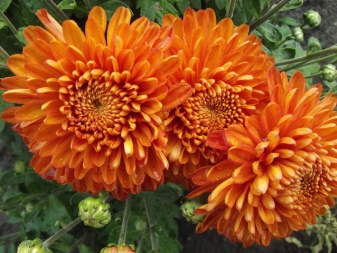
- late - November plants; varieties "Rivardi", "Larisa".
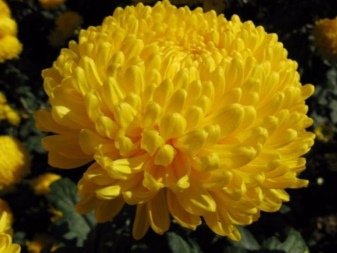
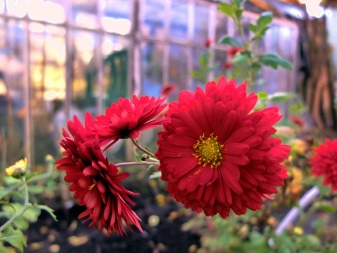
When choosing a particular variety that you want to grow outdoors, you must take into account the level of its cold hardiness.
Bushes are divided according to this quality.
- Cold resistant. Plants that are not afraid of the first snowfalls. These include representatives of such varieties as "Susan", Korean varieties.

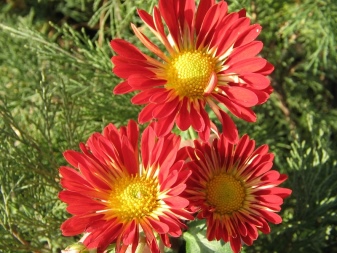
- For mild climates. For example, the "Fantasy" variety. Flowers belonging to this variety may not meet time and not bloom until the arrival of the first frost. Usually they breed in southern latitudes. It should be noted that the low non-double subspecies are resistant to cold air. The larger the "green pet", the less frost-resistant it is in the end.

The dimensions of the inflorescences are also a criterion by which different varieties are divided.
- Large-flowered. This type includes well-known varieties, for example, "Zembla Lilak", "Tom Pierce". The diameter of the “cap” of these varieties reaches 20–25 cm. Their shape is close to hemispherical. The stems are usually of sufficient height.These flowers are grown more often for subsequent cutting. Large-flowered chrysanthemums usually cannot withstand winter conditions outside.

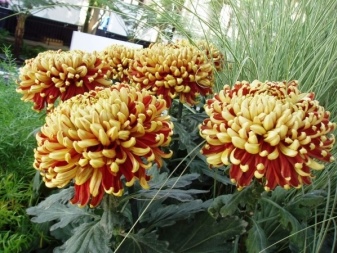
- Mid-flowered. These include the varieties "Golden Fleece", "Spray of Champagne". The inflorescences of these plants rarely exceed 8-10 cm. Such subspecies are mainly kept in garden settings or balcony areas.
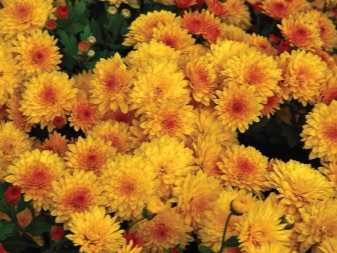
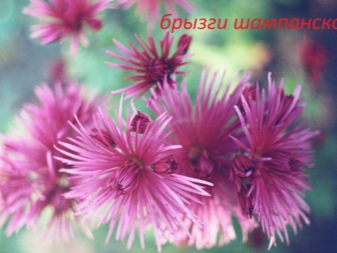
The described flowers can also differ in the structure of the inflorescences into two varieties.
- Simple. From these species come the varieties "Andre Rose", "Amazonka", "Baltika". The middle of the inflorescence is open, framed by one or a pair of rows of petals. Outwardly, these varieties are very similar to a large, beautiful chamomile.
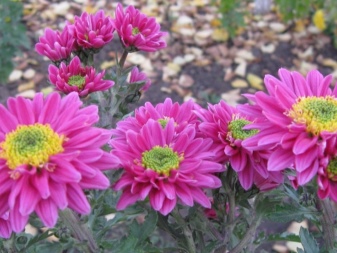
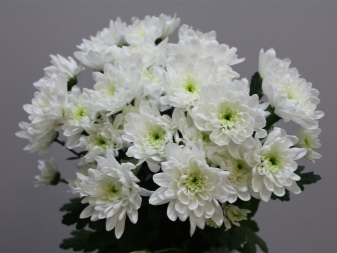
- Terry. This subspecies includes the varieties "Zlata Praga", "Gazella", "Trezor". Chrysanthemums with double inflorescences have rich rows of petals. They cover the entire center of the flower.
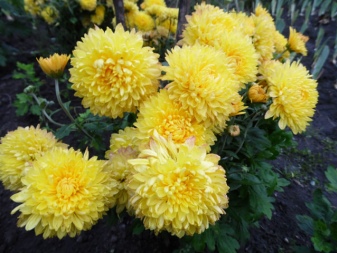

All chrysanthemums are subdivided into the types listed below.
- Ampelnye. Otherwise, it is called a cascading chrysanthemum. She was bred in Japan. Its flowers are very similar to those of a daisy. Their diameter rarely exceeds 2–4 cm. The plant is characterized by impressive growth and long shoots with a large number of colorful flowers.
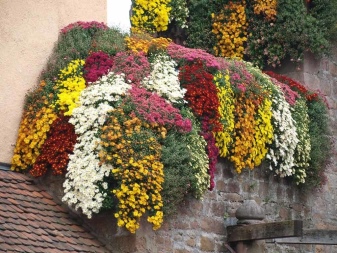
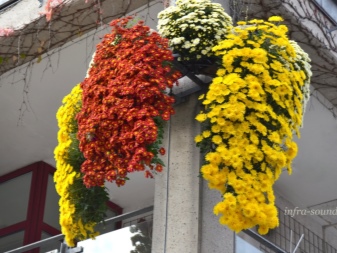
- Bristly. Such chrysanthemums immediately attract a lot of attention because they have thin and slightly curled petals. Outwardly, they resemble graceful brushes.
Such varieties look beautiful and impressive, so they are chosen by many growers.
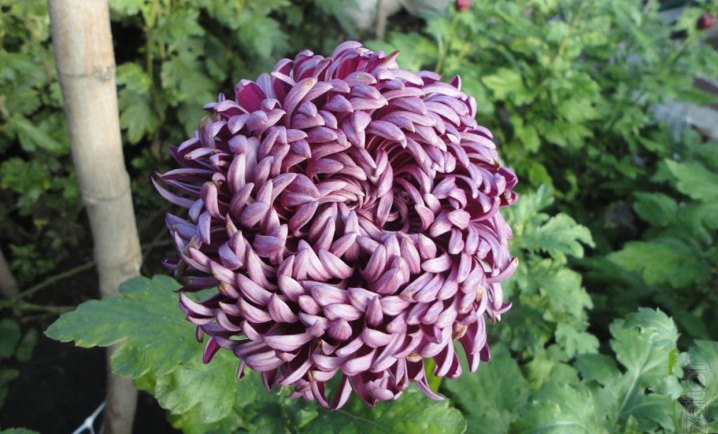
- Pompom. Chrysanthemums of these varieties boast a chic spherical shape. They are distinguished by increased terry, rich and juicy shades, long flowering in almost any growing conditions. "Round" varieties are insanely popular because they look gorgeous and do not need complicated care.
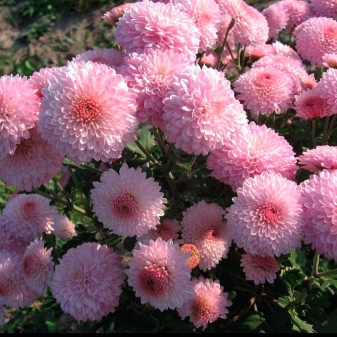
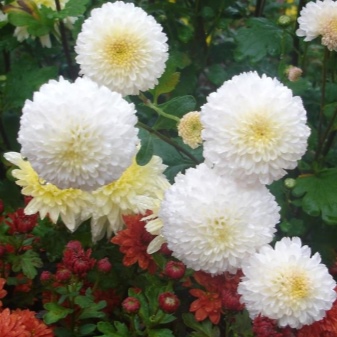
- Semi-double. These chrysanthemums boast a huge number of different shapes, structures and colors. The most striking and memorable representative of this category is a garden plant with slightly deflated inflorescences. Their middle is practically not covered, and on the edges there are petals of different scales and shapes. Semi-double specimens look colorful and original.
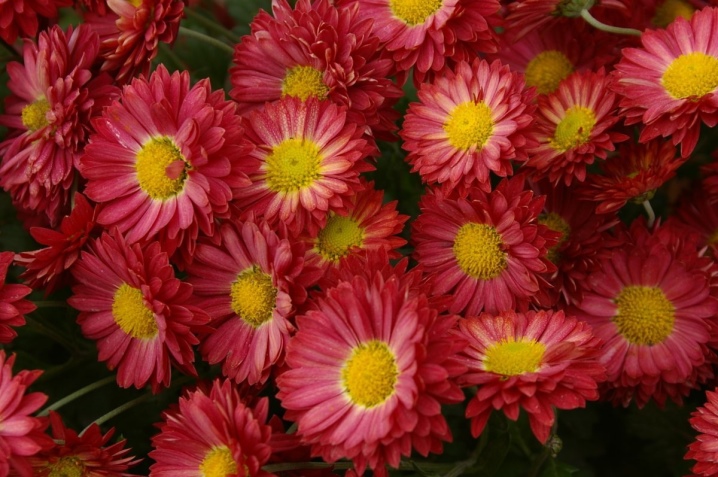
- Simple. Common varieties appear as graceful but discreet inflorescences. In terms of their external characteristics, they differ little from simple daisies.
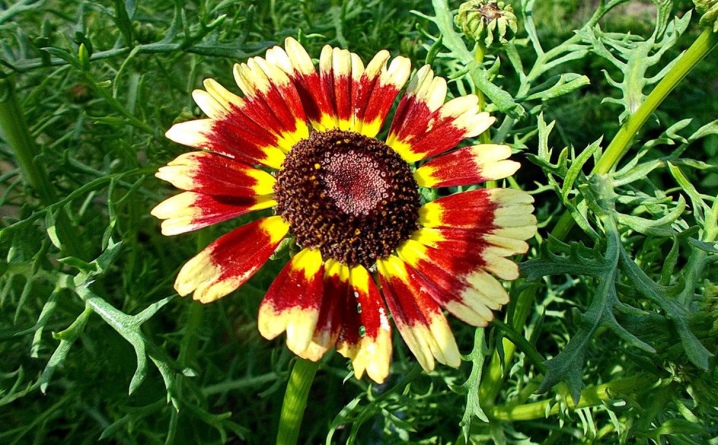
- Anemone-like. Such chrysanthemums can be easily recognized by their common shape and slightly prominent middle of the inflorescence. It rises slightly with petals, rushing towards the sun. These are some of the most delicate representatives of garden chrysanthemums. They exude a very pleasant and unobtrusive scent that many people like.
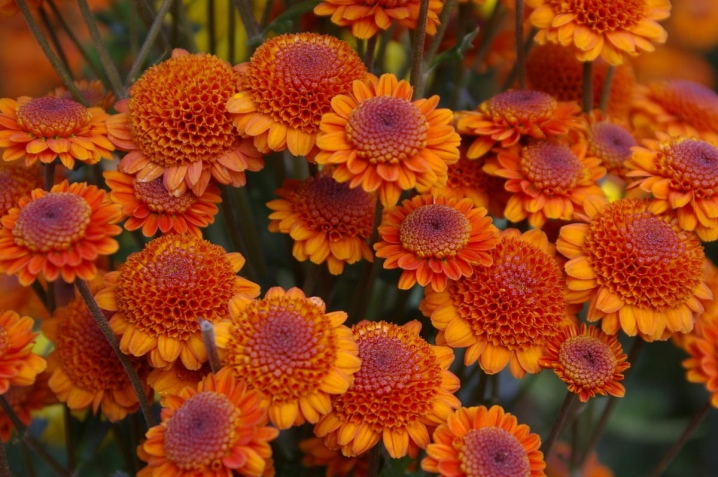
- Spoon-shaped. Such varieties of chrysanthemums are considered rare. They have a self-explanatory name - their petals are very similar in shape to small and neat spoons.

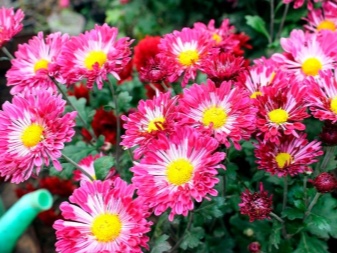
- Single-headed (solitary). The inflorescences of such representatives can be double or semi-double. Their usual diameter is 12–25 cm. The plant has a strong and resilient stem. The bud of a single chrysanthemum is also called a hat.
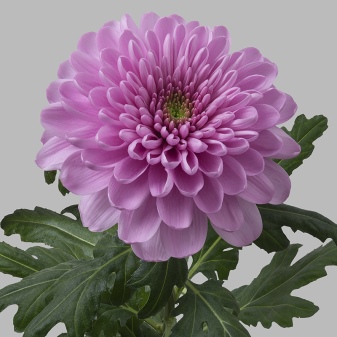

Home care
For home keeping, dwarf varieties of chrysanthemums are usually chosen, which are small in size and modest in height. It is easy to care for such plants. The main thing is to know exactly what conditions are required for indoor flowers. In order for the beauty in question at home to be healthy and delight households with rich flowering, she needs to be surrounded by a safe temperature. A mode of + 20– + 23 degrees is suitable. In spring and autumn, in the room where the flower pot is located, the air temperature should be + 15– + 18 degrees.
In winter, it is permissible to keep the chrysanthemum in a cool place, where the temperature is at least +3 degrees.
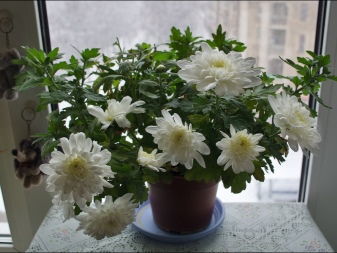
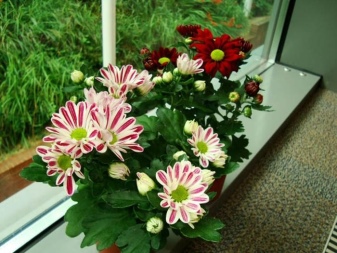
Lighting is important and correct. To place a flower pot, it is recommended to choose a window in the west or east direction.Chrysanthemums need only diffused light in sufficient quantities. These crops cannot be placed on the south side. On the northern windowsill, chrysanthemum blooms will be surprisingly meager, since there will be a lack of sunlight. Chrysanthemums are allowed to grow in a balcony area, loggia or veranda. These areas should be well lit as the flowers need sufficient sunlight. With the advent of warm seasons, it is recommended to move the plant to the garden.
Chrysanthemum must be watered correctly and in a timely manner. This procedure cannot be neglected, otherwise the pet will get sick and may die. The flower in question is related to moisture-loving varieties, therefore, the substrate in which it is located should be relatively moist. During the entire growing season, the bush must be watered at least 2 times every 7 days. Overdrying a lump of earth in the winter season is prohibited. It is necessary to ensure that no liquid stagnates in the soil mixture and in the pan, which leads to decay of the root system of the flower. Young flowers grown at home should be replanted once a year. To do this, you need to take a new pot, which is larger than the old one. Adult bushes are allowed to be transplanted a little less often - once every 2-3 years.
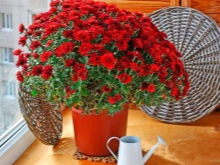
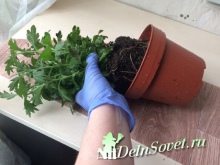
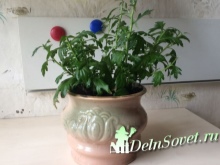
A home flower needs regular feeding. Experienced flower growers recommend using complex mineral fertilizers, which contain such necessary components as phosphorus and potassium, which stimulate the flowering of chrysanthemums. In order for the bush to bloom earlier than the expected date, it is necessary to accelerate its flowering. For this purpose, it is allowed to add a special solution of potassium monophosphate 1 to 10 to the soil, or use another complex fertilizer with phosphorus, nitrogen and potassium.
Adult flowers must be fertilized once every 1.5 weeks. Every 4 days, the soil mixture in which the chrysanthemum grows is supplemented with a mullein (a solution prepared from 1 bucket of water and 1 part of the fertilizer itself). When the formation of buds begins, all fertilizing of the flower is stopped. From the moment when the flowering of the home chrysanthemum is over, it must be left in a calm state. You will need to carefully cut all the stems from the bush and remove the pot with the plant in the cellar, where it will live until the beginning of spring.
When the first young shoots appear, the pet will need to be transplanted into a new, spacious pot and returned to its old place in the house.
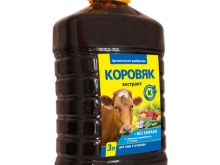
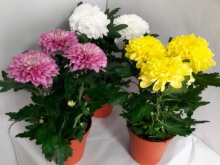
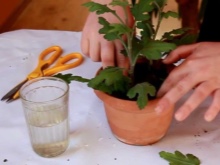
We take into account the climate and choose a place on the site
Many gardeners prefer to grow chrysanthemums not in a pot, but outdoors in the garden or in their backyard. For these purposes it is important to correctly choose the most suitable place where the plant will feel comfortable.
Choosing a landing site
A win-win place where the chrysanthemum will grow beautiful and healthy is a lighted, sunny area. During the day, this gorgeous plant needs at least 3 hours of sunlight. Of course, no one forbids planting chrysanthemums in a shaded place on the site, but in such conditions the plant will bloom sparsely... The flowers will not grow large, and the stem may grow too high, as if stretching upward in search of missing sunlight. Ideally, for planting chrysanthemums, you should select not only a well-lit, but also protected from the wind place, where there is a soil suitable in its composition and condition.
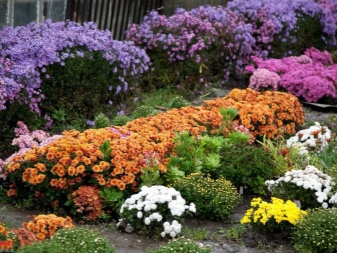
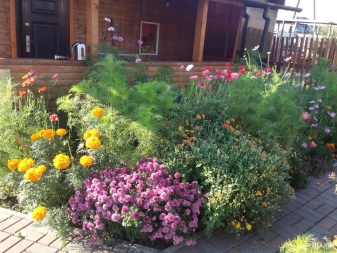
Soil requirements
Despite the fact that chrysanthemum is a relatively unpretentious plant, it is very important for its cultivation to find a place with suitable soil. The soil must be fertile, well fertilized, saturated with moisture in sufficient quantities. But it should not be too damp and wet either - in such conditions, the roots of the chrysanthemum can begin to rot, which will entail many serious problems, the flesh until the death of the flower.Chrysanthemums do not like dry peaty or sandy soil types. Lands that cannot boast of a rich mineral composition, poorly retaining moisture, will turn out to be completely unsuitable for such street sprouts.
Important! The best conditions for planting chrysanthemums are light, sandy loam soils. It is desirable that they are well flavored with humus and organic components. It is recommended to ensure that the soil is drained.

Temperature regime
Before proceeding with planting chrysanthemum seedlings in open ground, you need to figure out what climatic conditions for the selected variety will be safe. For example, in more severe conditions (for example, in the Far North) Korean varieties will easily take root. Such specimens can be safely planted in the Urals. Most varieties of chrysanthemums are designed for a mild climate.
So, one of the most common varieties is "Fantasy".
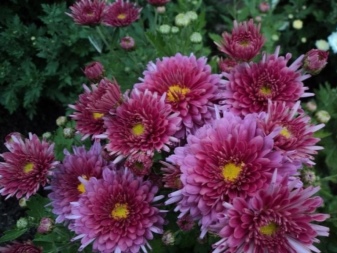
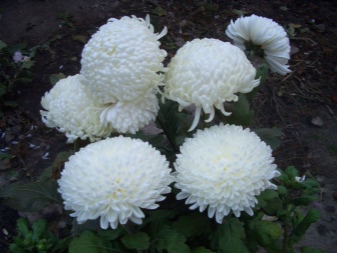
Experienced growers recommend planting flowers in relatively cool areas, where excessively high temperatures do not persist. On days when the sun is too aggressive, it is advisable to shade the plants, otherwise they can get serious burns. When choosing flowers of a certain variety, be sure to consider whether they are suitable for the climatic conditions in which you live. It is also necessary to take into account the optimal temperature parameters for each season, namely:
- optimal autumn temperature - + 15– + 18 degrees;
- temperature in the winter season - 0– + 7 degrees;
- in spring, chrysanthemums feel comfortable at temperatures from +11 to +17 degrees;
- the optimal summer temperature is up to +23 degrees.

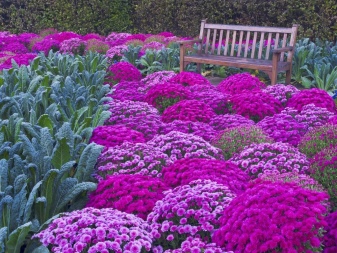
How to plant?
There is nothing difficult in planting chrysanthemums in open ground in a country house or country house. To do this, you can buy seedlings, buy ready-made seedlings, or choose a branch from the flowers donated earlier. Many growers decide to root this beautiful plant by taking it from a bouquet. Experts recommend planting a chrysanthemum from a bouquet at the very beginning of the autumn season. It is advisable to start such procedures before September 15 or closer to the end of spring. The optimal time period for planting a plant is early morning or evening hours, when there is no sultry heat outside. These plants bloom in August and are able to calmly endure small autumn colds. These flowers grow well in calm, light and open areas.
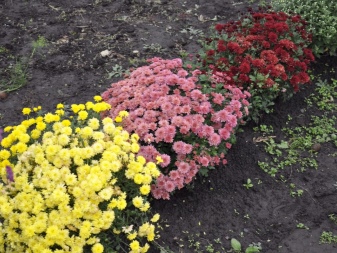
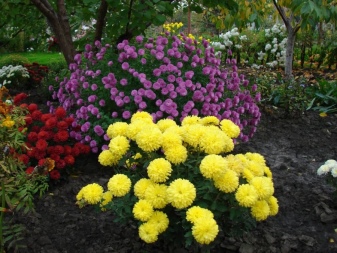
Before you start planting the future bush, you need to properly prepare the soil. First, you need to loosen it thoroughly, remove all weeds. Fertilizer will need to be applied to the ground: chicken droppings or manure. Cuttings in the soil must be placed in such a way that a distance of 30-60 cm remains between them. After planting, you need to prepare a weak solution of potassium permanganate and treat the surface of the soil with it. In order for the cut stems to take root in a new place, all old foliage, as well as faded buds, must be removed from them. It is advisable to update the branch slice.
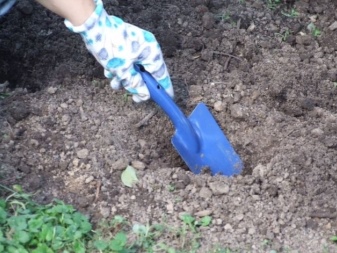
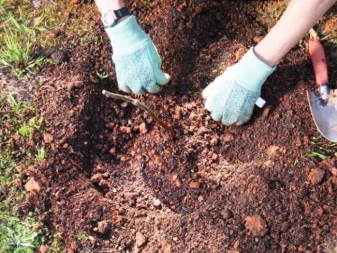
In order for excess liquid to drain off, it is worth preparing compact wells. In order for the flowers from the bouquet to take root faster, it is advisable to cover them with a special film or glass jar for a couple of weeks. It is necessary to ensure that the harvested shelters do not come into contact with the planted chrysanthemum runs. If you are using a jar, be sure to periodically air the selected cuttings.
To protect the flowers from the bouquet from wind gusts, you can make a small fence around them, which will also be an excellent support for weak stems.

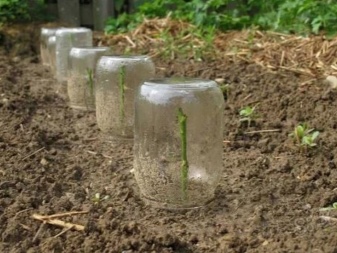
How to take care of it properly?
If you want to grow a really beautiful and healthy plant on your site, it needs competent care.
Watering
It is very important to water this plant according to all the rules. As mentioned above, chrysanthemums are moisture-loving plants. The substrate in which they grow should always be slightly moist. When the weather is too hot in the yard, you can turn to spraying the flower with a spray bottle. It is advisable to resort to this in the evening and in the morning. You can do without additional hydration of the chrysanthemum in the heat, but then it will dry out and will not be able to look beautiful.

Flowers planted in open ground should be watered as follows:
- in the first stages of growth, flowers need to be watered at least 1 time per week;
- it is necessary to thoroughly soak the upper soil layers without getting on the leaves of the flower;
- in the summer season, when the air temperature rises, watering can be done more often;
- by the September flowering stage, it is recommended to water the chrysanthemum at least 3 times a week.
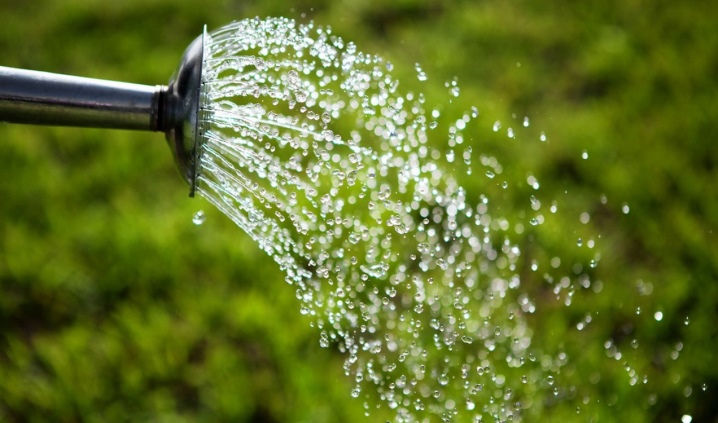
Top dressing
Chrysanthemums need high-quality fertilizers and a wide range of nutrients, namely such components as:
- nitrogen;
- potassium;
- phosphorus;
- sulfur;
- calcium;
- magnesium;
- manganese;
- iron.
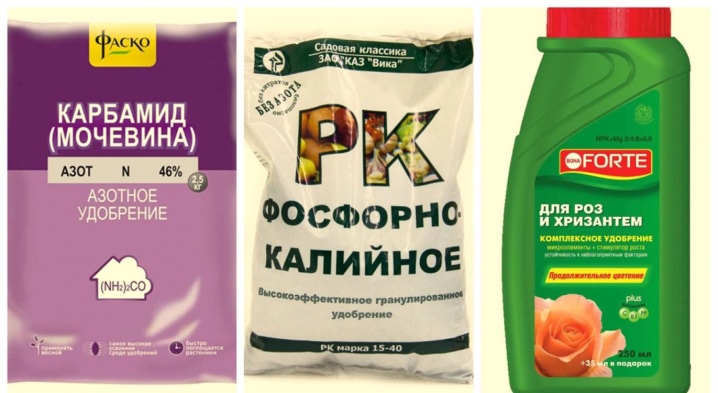
Experts strongly recommend choosing high-quality, high-quality complex fertilizers for plant feeding, which contain all the necessary components. If the flowers were planted during the current spring, then a couple of dressings will be enough for the season. If you planted flowers 1 or 2 years ago, then you will have to provide them with top dressing for the entire summer season. In the fall, you will need to fertilize such a chrysanthemum once a month.
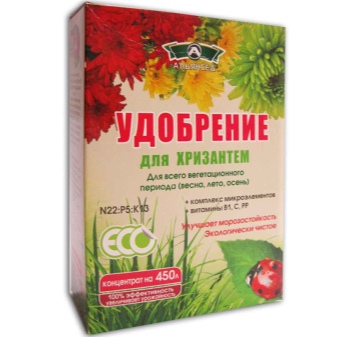

Pruning
For a planted chrysanthemum to be a beautiful and lush bush, it is important to prune it regularly. It is imperative to pinch the planted flower correctly. Such procedures are needed not only by garden pets, but also by potted green pets. In such cases, the following nuances must be taken into account:
- pinching chrysanthemums for the first time is necessary when the central stalk reaches at least 10 cm in height;
- the second pinching is allowed at the moment when the side shoots grow up to 10 cm;
- all further pinching should be carried out, taking into account the distinctive features and characteristics of the species, structure of the flower;
- the final pinch will be useful 2–2.5 months before the flowering stage;
it is always necessary to prune young stepchildren in a timely manner so that before the start of flowering there are no more than 5–6 stalks in the outlet.
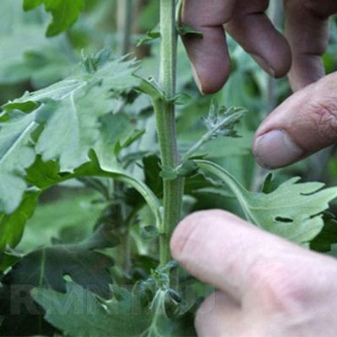
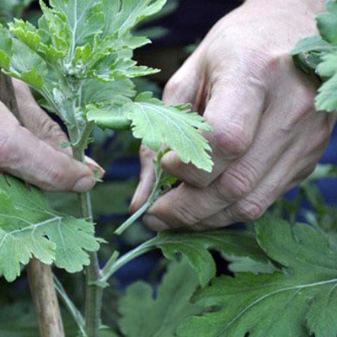
The following procedures may be helpful to ensure the plant has a rich and solid flowering:
- to get large chrysanthemum flowers, you need to remove the buds on the sides when they "hatch";
- in representatives of small-flowered varieties, to stimulate the flowering of lateral shoots, it is necessary to remove the bud in the center;
- regularly remove all the buds that have withered, this method will be able not only to form a beautiful plant, but also to prolong the flowering in general.
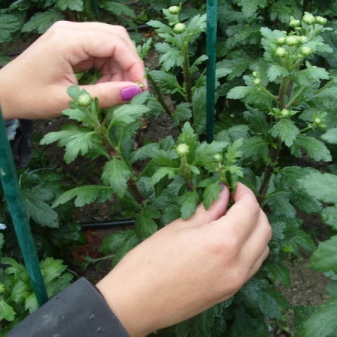
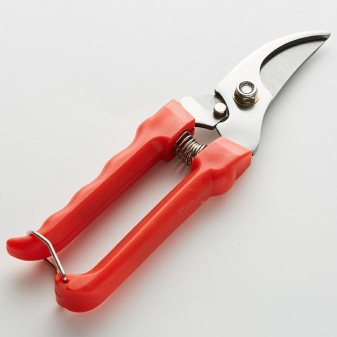
Dormant period
At the end of the flowering stage, the chrysanthemum goes into a dormant state. At such a time, winter is approaching and you need to find a safe place for the green pet to wait out this season. When a flower has stopped in a state of calm, it cannot be watered at all. It is recommended to implement this procedure at least once a month. Thus, the vitality of the flower will be successfully maintained.
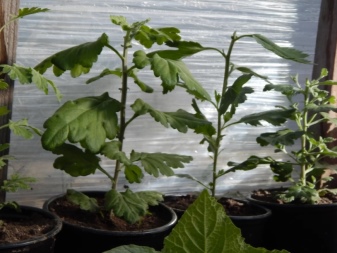
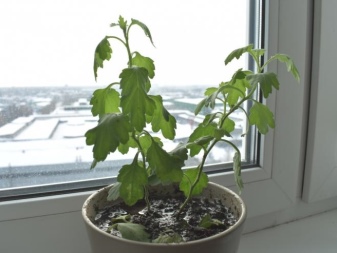
Transfer
Chrysanthemums need periodic transplantation. Young plants should be transplanted once a year, and adults - once every couple of years. This should be done in early spring, at the moment the growing season starts. Consider all the subtleties of the spring transplant of this plant.
- The bush must be dug out as carefully and carefully as possible from its original place. The earth will need to be shaken off. The mother bush is allowed to be divided into different parts using a pruner.
- It is required to allocate a new place for the flower. It should be well lit, away from groundwater.
- The dug out bush or its individual parts will then need to be transplanted into pre-prepared holes. After transplanting, the flowers will need to be well watered.At first, watering can be more frequent so that the flower can take root more easily and faster.
- The first feeding will be needed some time after transplanting. It is advisable to apply a liquid complex fertilizer for flowers.
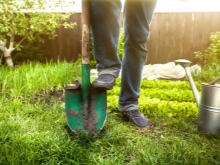
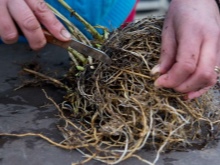
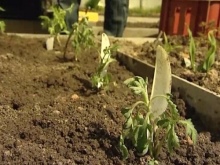
How to keep flowers in winter?
Many gardeners are interested in how to preserve chrysanthemums in the winter season. There are ways to store this plant in winter, such as:
- leaving in the ground;
- moving excavated plants to the house (basement or other suitable place);
- harvesting chrysanthemums in pre-prepared trenches.
Frost-resistant varieties of the flowers in question are allowed to be left in the open field for the winter.
But for this, the flower will need to be properly cut, leaving about 15 cm from the earthen layer. the bush needs to be mulched with needles or straw, humus hilling is required... As soon as the temperature drops to +5 degrees, the plant needs to be covered with oak or spruce branches. For shelter, in no case should you use fallen leaves. When the frosts are gone, the shelter must be removed in time. If there are night frosts, you can resort to laying a thick film.
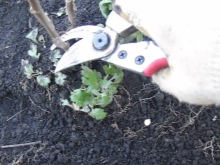
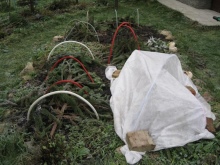
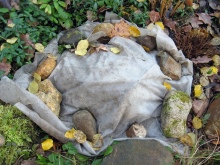
Often dug up chrysanthemums are removed to the cellar for the winter. This is one of the more popular solutions. Closer to the frost, the rhizomes of the flowers are carefully dug up and, together with an earthen lump, are sent to the cellar. The plant is placed directly on the ground. The room temperature should be between 0 and +5 degrees. With this temperature regime, chrysanthemums will be in a kind of "sleep" (rest) state. Young shoots do not stretch at this time. With the considered method, it will be possible to keep the plants under control and start germination at any time.
For the winter, you can place chrysanthemums in trenches, the formation of which must be carried out in advance. Carefully dug out flower bushes must be carefully, but tightly laid out in trenches, the depth of which is no more than 60 cm.When frosts come, the trench will need to be covered with wooden boards or a sheet of slate. On top you will need to lay a film and sprinkle the vine (leaves can be used). This method is popular, but it does not allow the grower to control the storage of the flower.
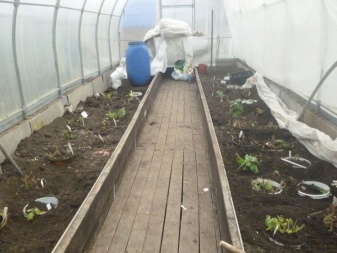
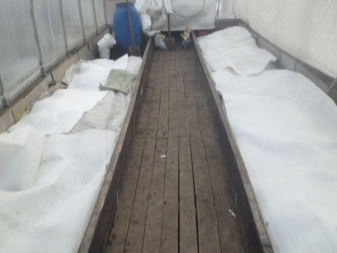
The subtleties of growing a house in a pot
Growing chrysanthemum in a pot at home, one should not only provide her with competent care, but also take into account the following subtleties of the content:
- to grow a chrysanthemum in a pot, you need to choose the right substrate for this; loose, light and nutrient-rich neutral soil is recommended;
- the soil mixture can be made independently, or you can immediately buy a ready-made composition in the store;
- the percentage of nutrients in the soil mixture will increase if chicken manure is added to it;
- after watering the potted chrysanthemum, all excess moisture should be removed immediately; before the subsequent addition of water, the surface of the earth should dry out quite a bit;
- potted chrysanthemums can be fed not only with specialized, but also with simple, universal mixtures; during the flowering period, the plant is especially in need of phosphorus and potassium, and during the formation of the bush - in nitrogen;
- as the foliage and flowers wither, they must be carefully trimmed;
- before wintering, it is recommended to cut the pot plant to the maximum, leaving only small "hemp" from the root system;
growing chrysanthemum in a pot at home, it is necessary to put it as far as possible from the battery and other heating devices.
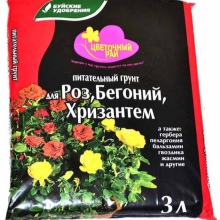
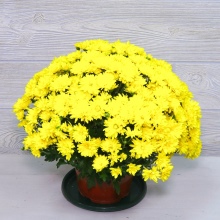

Reproduction methods
There are only a few basic methods on how to breed chrysanthemums. Let's consider them in more detail.
By dividing the bush
Reproduction of chrysanthemums in this way is one of the most popular methods. It is recommended to replant the bush after the flowering process is complete. It is at this time that new shoots are born, a fresh root begins to grow. It is necessary to carefully dig out the bush, shake it off and rinse the roots. Having separated a young shoot, it will need to be immediately planted in pre-prepared soil. If the stem is too tall, cut over the fourth leaf and cover the plant so the roots can easily take root.
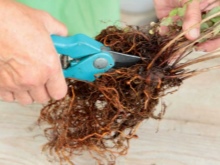
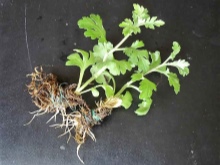
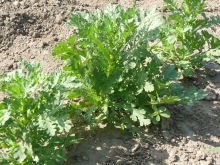
Seeds
This breeding option is also very popular. Seeds are allowed to be sown in the ground in May. It is best to plant 4–5 seeds per hole. If you want the flowers to break through earlier, you can first plant them at home in March, and then dive in pots and move them outside in the last days of May.
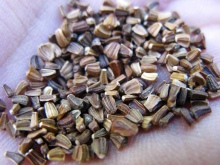
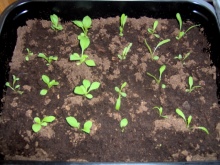
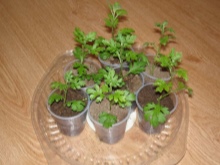
By cuttings
This method of reproduction of chrysanthemums should start with the selection of healthy plants - mother plants. At the end of the flowering period, green bushes must be selected and transplanted into a separate box. The mothers should be kept in a room where the temperature is from 2 to 5 degrees (not lower than 0). They need to be watered enough so that root shoots germinate productively. For cuttings, shoots are suitable that branches from the root itself. Such cuttings should be planted in pots with pre-prepared soil.
Sand and humus are required to be added to the soil mixture. Mineral fertilizers will not be superfluous (you can dilute a solution of 20 g per 10 liters of water). The plant takes root and takes root in about a month. After that, you can start transplanting to the garden, if weather conditions permit.

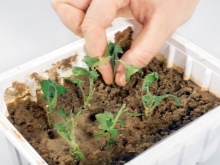
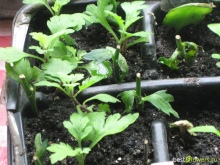
Why are they not blooming and what to do about it?
Colorful and bright chrysanthemums are usually grown to decorate a plot or house / apartment. It is quite a shame if the flowering still does not come or is very "late". Let's consider what reasons can lead to such problems and how they can be avoided.
- Little light. Chrysanthemums can only bloom well if they grow in areas well-lit by the sun.
- After wintering, the bush was later removed for germination. This procedure should be carried out in early March.
- The mother plant does not have the ability to rejuvenate at the right time. Before planting a plant in the ground, it must be thinned out without fail.
- Top dressing applied irregularly. It is necessary to remember about timely fertilization during especially active growth of green mass, when the plants produce foliage, buds are laid.
- Overdrying the soil. The ground around the flower should always be slightly damp to make the plant bloom.
- Late varietieswhose flowering period occurs in November or December.
It so happens that the flower does not have time to acquire flowers before the onset of severe frosts and sub-zero temperatures.
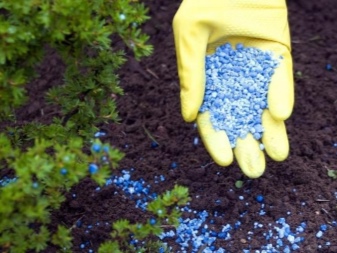
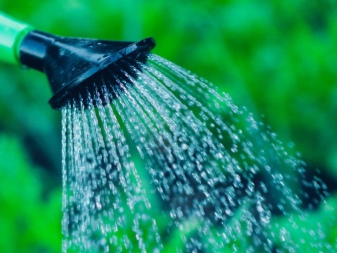
Diseases and pests
Chrysanthemums, like any other plant, are susceptible to certain diseases. They are often targeted by a number of dangerous pests. Chrysanthemums most often suffer from diseases such as:
- ring spot - when a plant suffers from such a disease, characteristic yellow spots appear on it, and the leaves wither;
- dwarfism - with this ailment, the growth of the flower slows down significantly, the flowers are tiny in size;
- seedlessness - with such a disease, the inflorescences are deformed and discolored;
- mosaic - leads to the appearance of stains on the foliage of the chrysanthemum, similar to a mosaic;
- powdery mildew is a very serious disease that affects garden flowers, indoor flowers, and wildflowers; chrysanthemums suffering from powdery mildew are covered with a clearly visible whitish bloom;
- rust - its main symptom is the appearance of red spots on the plant, yellowing of the leaf plates;
- gray rot - manifests itself in the formation of a gray bloom on the flower, as a result, the plant almost always begins to rot;
- septoria - with it, noticeable yellowish spots appear on the flower.


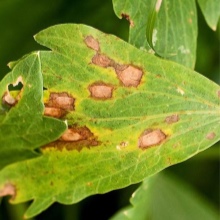
Important! To help such a herbaceous pet, specialized medications should be used.Colloidal sulfur, Bordeaux liquid will do.
Most often, chrysanthemums suffer from attacks from the pests described below.
- Spider mites and aphids. These pests take all the juices from the plant, which soon leads to the loss of color of the chrysanthemum and its inevitable wilting. You can get rid of pests with a powerful water jet or treatment with insecticides, copper-soap solution.
- Leaf nematode. A serious parasite that affects Chinese, Korean, Dutch, and any other species of chrysanthemums. Nematodes look like roundworms. Their appearance is accompanied by the formation of yellow-brown spots on the leaves of the plant. Then they start to merge, the flower dries up.
It is necessary to remove this pest together with the surrounding soil.
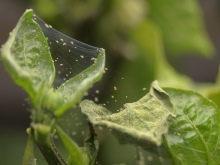
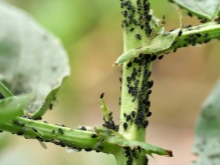
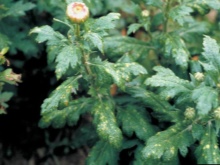
Possible problems
Growing chrysanthemum at home or on the site, A florist can face a number of common problems.
- Potted plants wither. This can be due to inappropriate air temperature, excess watering, the presence of pests and diseases. It is necessary to provide the flower with all the necessary conditions for growing, monitor its condition in order to notice in time that it is sick.
- The buds are falling. Chrysanthemum buds fall off and dry out more often due to the fact that they are in conditions of excessively high air temperature.
- Slow growth, tiny flowers. Such a problem will indicate that the flower does not have enough sunlight. Too elongated, disproportionate stems will indicate the same.
- Drying of the flower. If you do not remove drying foliage during flowering, the chrysanthemum may dry out. Do not neglect proper watering. The flower loves water, but not its excess.
- Rotting. It can start from the roots. A common problem if the plant gets too much moisture or is in the wrong soil.
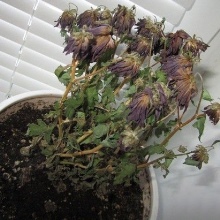
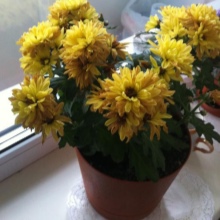

If you provide the considered flower with the necessary care and growing conditions, then there will be no problems with it. Chrysanthemum is an unpretentious creature, so it will not be difficult to save yourself from unnecessary trouble.
Use in landscape design
Bright and eye-catching chrysanthemums can be a chic decoration of any site or garden. Being in a beautiful flower bed or just in the open ground against the background of a neatly mowed lawn, they always attract a lot of attention, making the atmosphere livelier and more elegant. The plants in question look amazing in a single composition with other beautiful flowers. On one site it will be interesting to combine chrysanthemums with roses. As "neighbors" you can plant zinnias, peonies, asters. Beautiful alstroemeria is also suitable. Chrysanthemums, planted in a multi-tiered flowerbed with other rich and variegated crops, for example, with delphinium, dahlias, daisies and manadras, look gorgeous.
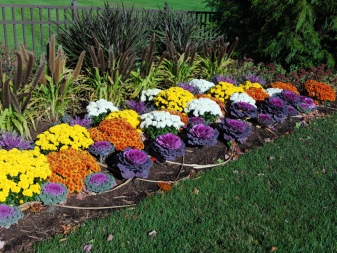
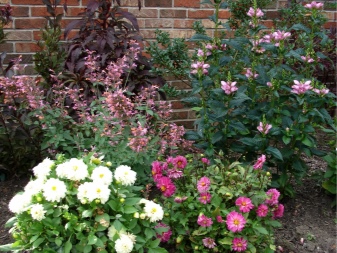
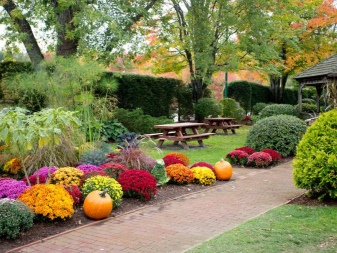

For all the intricacies of growing chrysanthemums, see the next video.







































































































The comment was sent successfully.